JHP Newsletter - 2010, No. 5, 23 November
Greetings from Parker, Colorado, our unofficial home base.
We had a fantastic time at the North Rim of the Grand Canyon and in Utah since the last Newsletter.
Equipment: Canon EOS 1D Mk IV
I purchased a Canon EOS 1D Mk IV to get ready for my trip to Africa starting in February 2011, and it's a wonderful upgrade from the 1D Mk III. First, it has 16 mega-pixels instead of the 10 in the Mk III which is almost as many as were in my first digital "landscape" body, the 1Ds Mk II with 16.7 mega-pixels! Second, it's possible to select any one of the 45 autofocus points again, something that was taken away in the Mk III, and I really like the ability to frame my shots without having them driven by the position of the autofocus points as much. Third, it has better high-ISO performance than the Mk III, so I'll have even more options in low light situations.
Equipment: Apple 17" MacBook Pro
I decided to bite the bullet and upgrade my laptop, and only computer right now, after the logic board in my 15" MacBook Pro died. I had delayed upgrading because I used an eSATA adaptor in the ExpressCard slot, and the Unibody 15" MacBook Pros don't have an ExpressCard slot earning them the nickname "MacBook SemiPro." I had to rework my desk and purchase a new hard case to accommodate the larger machine, but I'm glad I did. The 2.8GHz Intel Core i7 processor can run circles around the older 2.6GHz Intel Core 2 Duo processor, and the 8GB of RAM, compared to the maximum 4GB of RAM in my old machine, reduces the amount of virtual memory that is used. I've added a 240GB SSD (Solid State Drive) in the optical bay using a MaxConnect Optical Bay Kit to use as my boot drive with a separate partition for Photoshop scratch space. The SSD provides a huge performance boost. Applications launch incredibly fast, and virtual memory and Photoshop scratch performance are greatly enhanced.
Travel: North Rim, Grand Canyon
On our way from southern Arizona in late August to the Wasatch Mountains near Salt Lake City, Utah, we stopped at the North Rim of the Grand Canyon, at the beginning of September for nine nights. It was Jan's first time there, and only my second time there. We boondocked in the Kaibab National Forest near Grand Canyon National Park, and photographed both inside the park and in the National Forest. One of my favorite locations in the North Rim of Grand Canyon National Park is Point Imperial which provides a good view of Mt. Hayden, the small white spire near the center of the image below left. A three-stop hard graduated neutral density filter was perfect for balancing the exposure between the bright sky and the darker formations at dusk. I love to photograph the Grand Canyon at dusk or dawn because the diffuse light provides even illumination down in the canyon. We also explored the area just to the west of the National Park, and it was my first time there. Photo ops were good at Fence Point (below center) and Locust Point (below right).
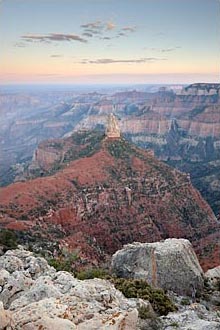
Point Imperial
Park, Arizona, USA
3-stop hard grad ND,
1/4 sec, f8, ISO 100
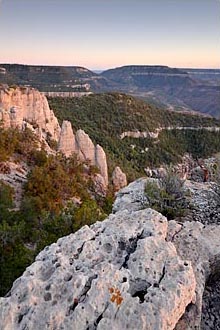
Kaibab National Forest, Arizona, USA
3-stop hard grad ND,
1/4 sec, f8, ISO 100
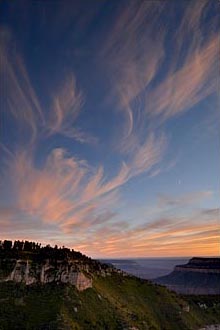
From Locust Point
Kaibab National Forest, Arizona, USA
3-stop hard grad ND,
1/6 sec, f8, ISO 100
Travel: Wasatch Mountains, Utah
We spent almost a month boondocking in the Wasatch Mountains around Salt Lake City beginning in mid September to photograph the fall color. Jan had wanted to go there for years, and it was my first time there too. The big draw is the red maples, something quite different than the monotonous yellow aspens we get in Colorado. We started out near Wasatch Mountain State Park, and the red maples were nearing peak. We had a nice sunset one day, and the orange clouds were a great addition to the fall foliage (below left). The image was created from two captures, one exposed for the bright sky and one exposed for the darker foreground, and then combined by hand in Photoshop. We came across a nice cow and bull moose one morning, and enjoyed photographing them among the fall color before they moved off into the forest (below right).
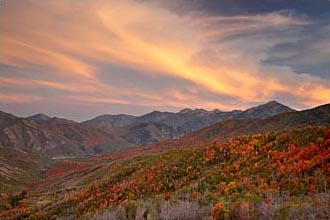
0.3 & 1 sec, f8, ISO 100
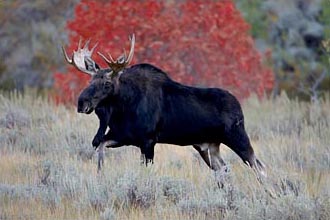
1/90 sec, f5.6, ISO 640
One evening, we photographed from an area with a huge patch of low oaks, about two or three feet (60-90cm) tall, that were orange and yellow. The clouds weren't terribly interesting, but the carpet of orange oaks sure was (below left). The image was created from five exposures to capture detail in the extremely bright clouds and the much darker foreground, and then combined by hand in Photoshop. One morning, we went to photograph Bridal Veil Falls. The falls face the west, and we took advantage of the nice diffuse light before they received direct sunlight. My favorite images of the falls were intimate views near the base (below center). I used a polarizer to remove most of the reflections from the wet rocks and a three-stop solid neutral density to lengthen the exposure and blur the moving water.
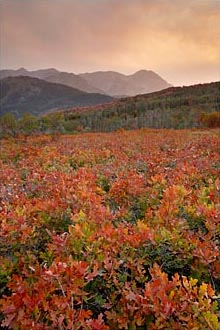
2, 1, 1/2, 1/6, & 1/8 sec, f16, ISO 100
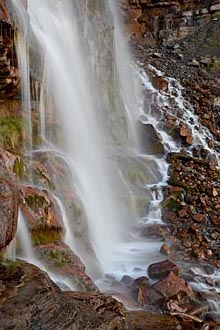
24-105 (at 55mm),
polarizer, 3-stop ND,
4 sec, f11, ISO 100
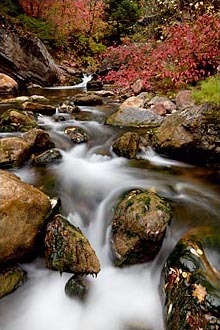
Utah, USA
polarizer, 3-stop ND,
3 sec, f11, ISO 100
We moved down to the Nebo Loop and had a blast photographing some cascades along the Peteetneet Creek (above right). We put on our gum boots so we could go stand in the creek and get in just the right position to photograph. The rushing water over the boulders with fallen leaves and red leaves in the background were wonderful! I used the shift motion of the 24 Tilt-Shift lens to look down without tilting the camera down in order to avoid keystoning, and I used the tilt motion to align the plane of focus along the stream to get the whole image in focus without stopping down and reducing sharpness due to diffraction. I also used a polarizer to remove most of the reflections from the wet rocks and a three-stop solid neutral density to lengthen the exposure and blur the moving water.
We moved to the Skyline Drive in the Manti - La Sal National Forest. The aspens at the high elevation were turning color, and we had some really nice sunsets (below left and right). Both images were created from multiple captures (two for the left and three for the right) to retain detail in the bright sky and dark foreground and then combined by hand in Photoshop.
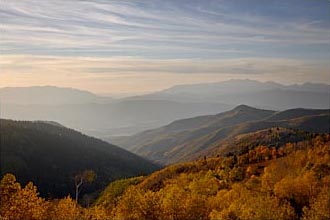
1/250 & 1/125 sec, f8, ISO 100
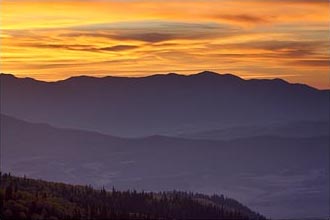
1/8, 1/4, & 1/2 sec, f11, ISO 100
Travel: Canyonlands National Park and Grand Staircase - Escalante National Monument
In the middle of October, we went to the northern part of Capitol Reef National Park for six nights. It was another first for Jan and a park that I had only visited once before. The cottonwoods were just starting to change color when we arrived, but the weather wasn't very cooperative. Most of the time it was either clear (bad for photography but good for solar-electric power) or completely cloudy (bad for photography and solar-electric power). On our first night there, we couldn't resist the near-full moon rising above the red rock cliffs, and I was able to capture a nice image of the moon "supported" by Chimney Rock (below left). Another day, I went out to photograph when the clouds broke in the afternoon, but they had moved back in by the time I was in position to photograph. So, instead of photographing the red rock formations with some nice clouds, I turned my lens towards the ground to capture the dry cracked ground (below right).
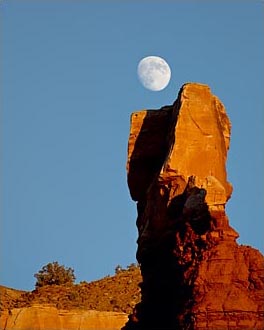
1/45 sec, f11, ISO 100
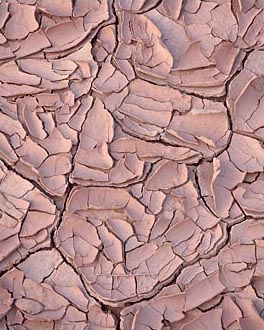
1/8 sec, f11, ISO 100
One overcast afternoon, we drove down the Scenic Road and then took Capitol Gorge Road, and the diffuse light was perfect for photographing in the narrow gorge. I mostly focused on isolated trees and bushes against the rock walls (below left). I went out another afternoon after some storm clouds started breaking, and I was able to capture a nice image of Chimney Rock before the clouds closed in again (below center). I used the shift motion of the 24 Tilt-Shift lens to look down without tilting the camera down in order to avoid keystoning, and I used the tilt motion to place the plane of focus through the boulder in the foreground and near the top of the formations in the background to get the whole image in focus without stopping down and reducing sharpness due to diffraction. Even though we were primarily interested in fall color, we photographed some wildflowers, including some Linearleaf Paintbrush (below right).
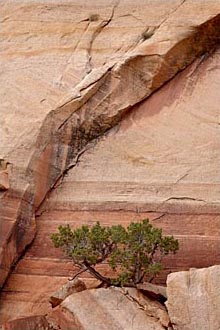
100-400 (at 200mm),
1/4 sec, f11, ISO 100
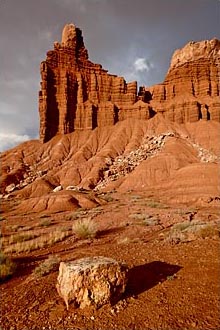
1/125 sec, f11, ISO 100
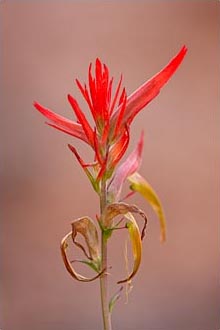
1/45 sec, f5.6, ISO 100
We left the northern section of Capitol Reef National Park and moved down to the neighboring Grand Staircase - Escalante National Monument and boondocked along the Burr Trail Road near Boulder for five nights. The Burr Trail Road goes along the bottom of Long Canyon, a fantastic canyon that's mostly about as wide as it is deep. The nearly vertical red rock walls reflect some fantastic warm light in the mid morning and late afternoon, and the cottonwoods had wonderful yellow leaves (below left). I used the shift motion of the 90 Tilt-Shift lens to look up without tilting the camera up in order to avoid keystoning.
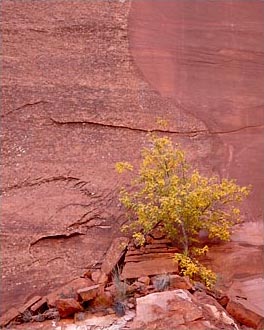
National Monument, Utah, USA
1/10 sec, f11, ISO 100
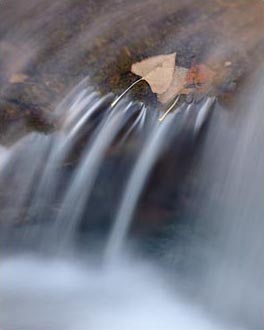
National Monument, Utah, USA
polarizer, 3-stop ND,
4 sec, f16, ISO 100
We stopped at Calf Creek and hiked out to Lower Calf Creek Falls. I had been there on my previous visit to the area, and I wasn't that impressed with the falls this time either. An almost-solid cloud layer provided some nice light, but it was extremely windy and I couldn't get excited about photographing the falls as I was getting drenched by the spray. We camped in the campground at the trailhead, and I thoroughly enjoyed photographing the small cascades in the campground the next morning. While it was cold, it was calm and I could take my time. My favorite image is an intimate look at some fallen cottonwood leaves trapped under the water (below right). I used the tilt motion of the 90 Tilt-Shift lens to align the plane of focus along the cascade. I used a polarizer to reduce some of the reflections from the water and a three-stop solid neutral density filter to lengthen the exposure to blur the moving water.
Travel: Zion National Park
We spent six nights in Zion National Park at the beginning of November. It was our first time to photograph fall color in the park, and we were a little early this year. The leaves were just starting to turn down in the valley when we arrived, but they were nice in the higher elevations in the eastern part of the park.
The eastern part of Zion is comprised of sandstone folds with many washes filled with maples and other trees, and the leaves were near peak fall color (below left). While exploring the wash where the previous images was taken, I was drawn to a plain old green bush growing in a crack in the sandstone (below center). I used the shift function of the 24 Tilt-Shift to look up without tilting the camera up and the shift motion to align the plane of focus along the rock. I also took some time to photograph a Rock Squirrel that was hanging out in the campground one day (below right), and it was the first time I used my new 1D Mk IV.
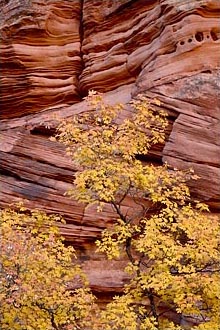
100-400 (at 190mm),
0.3 sec, f16, ISO 100
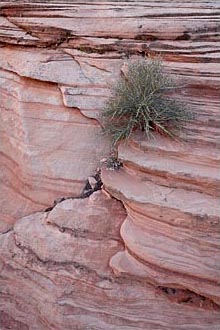
1/8 sec, f11, ISO 100
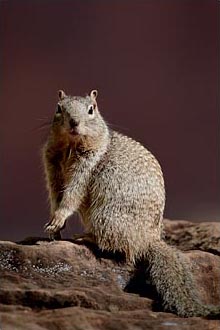
1/750 sec, f8, ISO 640
We hiked The Narrows for the first time and had a ball. The hike follows the North Fork of the Virgin River, and a good part of the hike is done in the river itself, so Jan and I wore our hip waders to stay dry. In the late morning and early afternoon, the sun reflects off the walls of the narrow canyon and creates some wonderful light. There were lots of cascades to evaluate as possible photographic subjects, and some were fantastic. My favorite set of cascades formed a circular pattern (below left). I used the shift motion of the 24 Tilt-Shift lens to look down without tilting the camera down in order to avoid keystoning, and I used the tilt motion to align the plane of focus along the cascade and the trees in the background to get the whole image in focus without stopping way down. I used seven stops of solid neutral density to really blur the moving water. On our way back to the Jeep, we stopped to photograph some small falls along the Riverside Walk (below center), and I love the diagonals created by the flowing water and the line of trees. Only five stops of solid neutral density were required to really blur the water because the light level had dropped. Shortly before we left the park, the trees down in the valley started developing much more color, and the mix of yellow and orange leaves with some evergreens against the steep cliff wall was nice (below right).
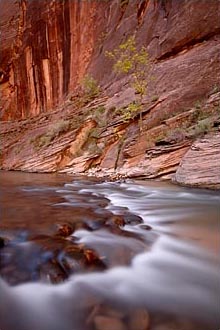
7-stops ND, 30 sec, f11, ISO 100
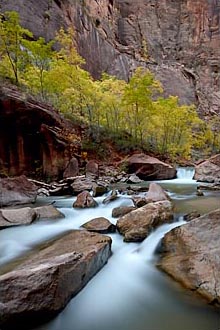
5-stops ND, 30 sec, f16, ISO 100
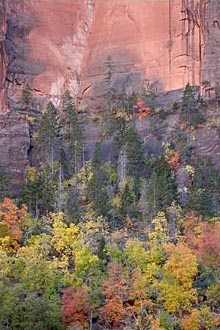
100-400 (at 130mm),
1/6 sec, f11, ISO 100
We would have loved to stay in Zion longer, but we had some commitments in the Denver area.
Take care and happy shooting.
— James
James Hager Photography :: www.jameshagerphoto.com




